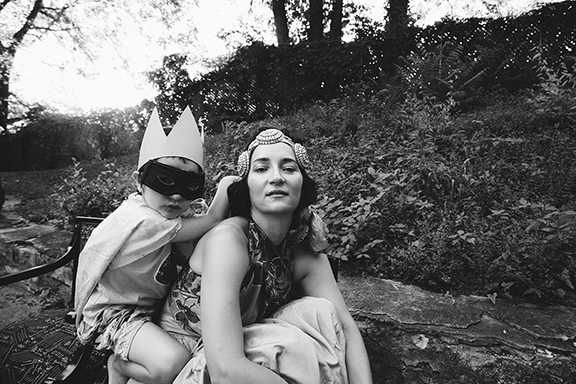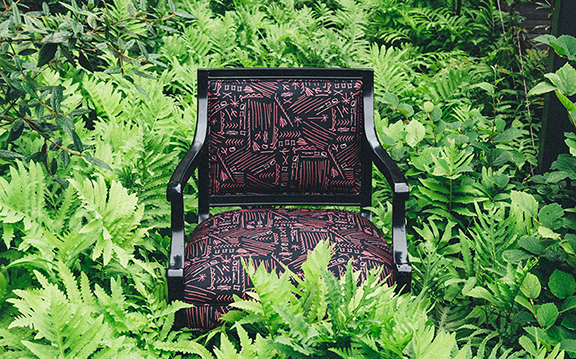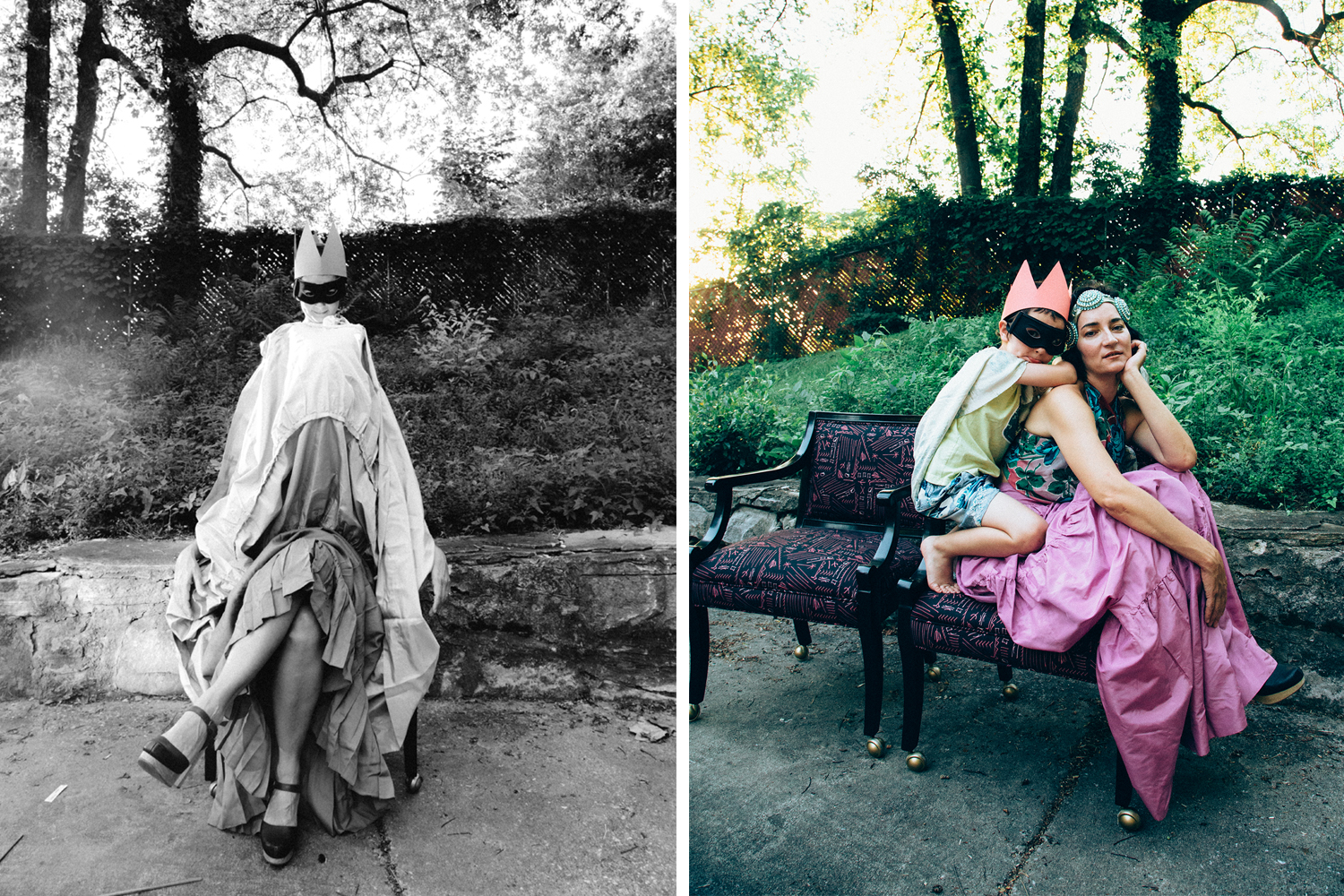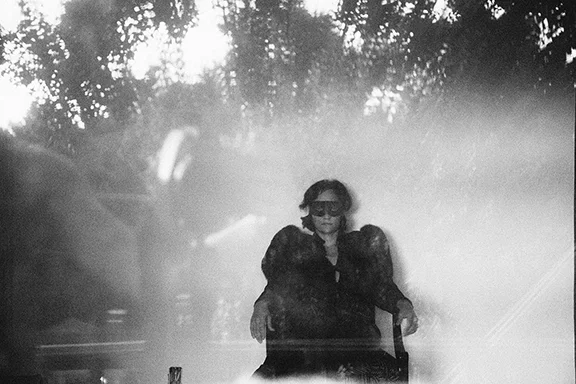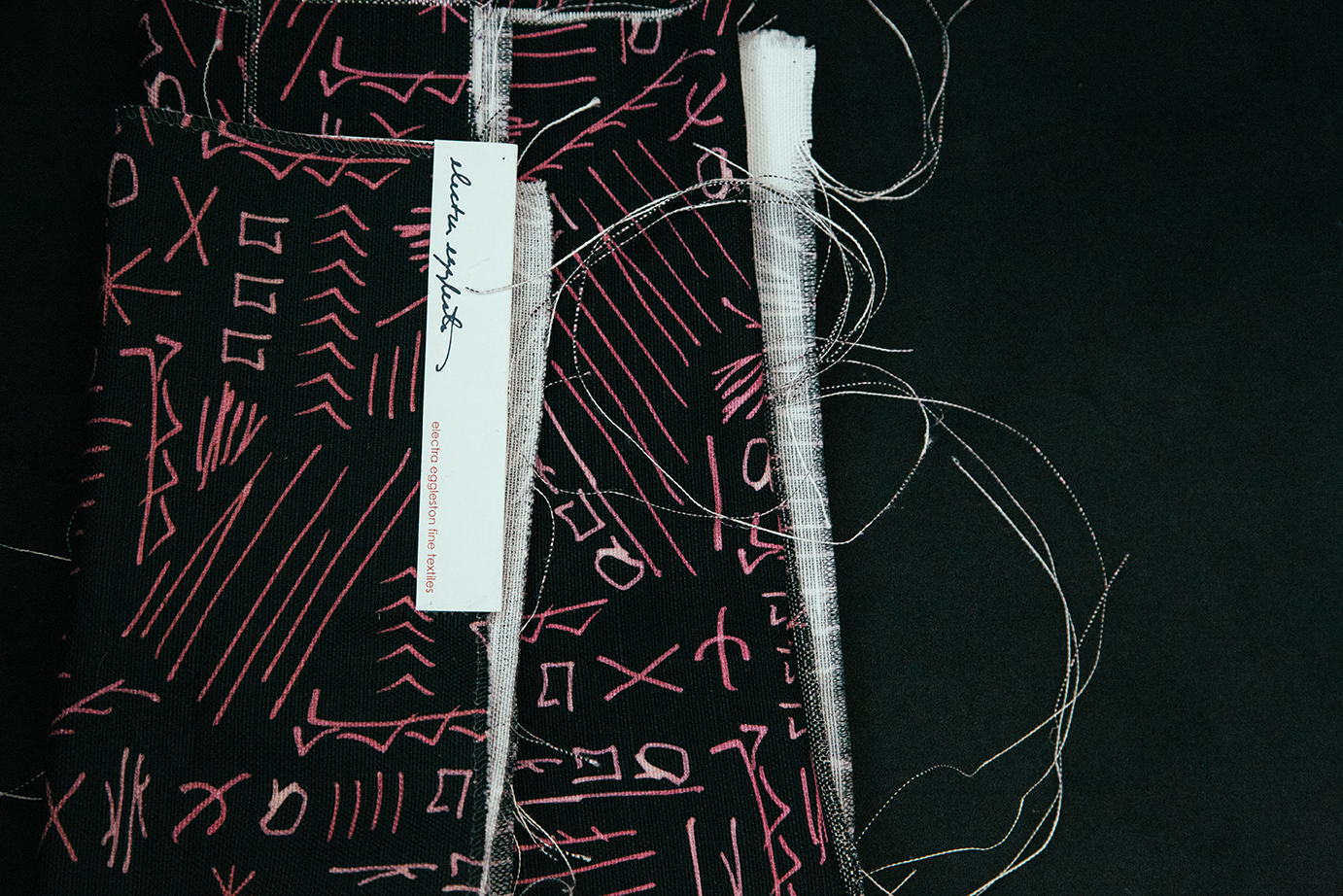Andra Eggleston, Textile Designer & Owner of Electra Eggleston
About ten years ago, I got an incredible assignment from a travel magazine: drive from Nashville to Miami, stop at every thrift store along the way, and write about it. No twisting of my secondhand blouse-covered arm was needed for me to accept.
On one of the last days of my trip, I came across a pair of Regency-style chairs at a junk store in Naples, Florida. They had terrific lines and sat on round metal casters. The paint job on the wooden frame and vinyl upholstery had seen better days (and perhaps too many damp bathing suit bottoms), but that’s what you get for $10.
I didn’t really have room for them in my car, but there was no way I was going to leave them there. I wedged them into the back, by then filled with several dozen bags of vintage clothes, and drove home to Tennessee with a rear view that was more than partially obscured.
I used the chairs as-was for years. They didn’t look terrible-terrible, but they definitely needed to be reupholstered. But I wasn't willing to throw just anything on them and I couldn't find a fabric I loved. These were special to me, and they deserved a special textile. I didn't know what I wanted, but I knew that I’d know it when I saw it.
Two months ago, I finally pulled the trigger. The winning fabric: a pink and black hieroglyphic print called “Cairo” by Electra Eggleston, the textile company belonging to my friend Andra Eggleston.
If Andra’s last name sounds familiar, you can thank your art history teacher. Her dad is William Eggleston, the Memphis-based photographer who is widely considered to be the father of color photography. Electra Eggleston is a project that the father-daughter team shares. William supplies the artwork – little paintings and sketches, some of them tossed off on the back of receipts, others taken from his archives (read the EE process story here)— and Andra turns each into a repeat. The finished patterns, named after an international locale (Berlin, Havana, Kentucky, etc.), are then sent to North Carolina to be printed onto gorgeous silks and linens.
I love every one of Electra Eggleston’s 15 prints, but Cairo really spoke to me. Design-wise, it’s perfect for the chairs — a dynamic, almost edgy black, white and pink Egyptian motif that’s a cool juxtaposition to their traditional silhouette. You can see for yourself in the photos here.
I’ve been waiting for the right time to feature Andra on TCR and this week felt good for a few reasons. First of all, my chairs’ homecoming seemed like a great opportunity to sit down with her to talk about the life that led her to textile design and Electra Eggleston. Plus, this Sunday is Father’s Day, the perfect time to talk to Andra about her dad and growing up. William Eggleston is famously eccentric and Andra had a colorful childhood, which she recounts here with remarkable candor and humor. (You can see their father/daughter dynamic in action this Sunday, when the two will be featured in a segment on CBS Sunday Morning.)
This story also presented a great excuse for me to finally collaborate with Heidi Ross, a Nashville-based photographer and all-around creative juggernaut. She photographed Andra and Louie, her son with husband Emery Dobyns, playing dress-up, lounging on my recovered chairs and sneaking around the worksite of the home they're renovating in East Nashville. It’s a beautiful, moody shoot and I’m very proud to share it, along with Andra’s beautiful and honest interview.
This interview has been edited and condensed.
TCR: What was it like growing up with a famous last name?
AE: Difficult. Not comfortable.
TCR: Really?
AE: As an adult, I feel differently about it. I'm so proud of my name, and I really honor how long it took my dad to get where he is. And I'm just so grateful. But when I was a kid, I didn't want to be an Eggleston. It was just a really unpredictable, really unsafe feeling for me. There were always stories about my dad in the newspaper. And I always felt like an outsider. Always.
TCR: A lot of his success came in the '70s when you were younger.
AE: His big, monumental success came in 1976 when he had his first one-man show at the MOMA. I was five then. My memories of his career and of being a kid were that it was just wild.
One time, I woke up in the middle of the night hearing gunshots in my house. And my dad was just firing (a gun) at a wall. There would be a shot and then after I'd hear my mom go, "Oh!" Gunshot. "Oh!" Gunshot. “Oh!” [LAUGHS]
TCR: One of my first memories of meeting you was at a dinner party a few years ago. We were talking about A Clockwork Orange for some reason, and you said, "Yeah, I watched that when I was six."
AE: I watched it with my mom. [LAUGHS] Any other mother would have been like, “We're turning this off.”
TCR: But in your case, it’s like, “Nihilism's a good thing for you to know about.”
AE: I was just that kid, though. I think I came into the world a little bit afraid. I came out dodging snowballs. You know? But I got through that.
TCR: Memphis and Nashville are only three and a half hours away and yet the culture of each is so different.
AE: So different. For me, the biggest difference is that so much of Memphis's history is grounded in violence. I mean, Martin Luther King was assassinated there, the Civil Rights movement (was happening there in full force), the Mississippi River was the hub of the slave trade… And of course, there's blues versus country. Blues music is more violent than country. Country feels wholesome to me; blues does not.
TCR: Also, the avant garde art scene that I understand was happening in Memphis 40 or so years ago was not happening here.
AE: It really was happening there. Truly. The cast of characters around my dad was real. The entourage that he had in Memphis was totally insane. And the city is so eccentric. I think it's no accident that my dad came from Memphis.
TCR: Was art part of your life growing up?
AE: Art was a part of my life in every shape and form. I really couldn't get away from it. It was multidimensional for me. It wasn't just photographs. My dad was drawing all the time. Music was profound. My dad played piano. I grew up around a piano and a harpsichord and five synthesizers. There was music all day, all night.
So, it was a very eclectic and creative environment. My mom was very literary. Together, my parents were very theatrical. It was something you realize only in retrospect, but they were colorful in the best way. And it really shaped who I am. I spent so much of my younger years resisting that part of myself because it was very unsettling. I didn't ask (to grow up in such a vibrant environment); it kinda got thrown into my face. My inherent personality requires that I be calm and centered, and this just didn't pair up with it. But now I'm so grateful.
TCR: You were surrounded by nonconformity as a kid. So how did you rebel?
AE: That’s a really good question! It was hard. [LAUGHS]
I rebelled in my sense of humor, which got me into trouble a lot. I was on conduct probation my whole freshman year in high school. I almost got kicked out and switched schools in tenth grade. I was in supervised study. I lived in detention. I was just always up to no good.
I wasn’t outspoken. I wasn’t the loudmouth. I would just do things that were disruptive. I was a real instigator, too. It’d get everyone else worked up. [LAUGHS]
In college at the University of Tennessee, I got kicked out of my sorority, which falls right in place with my behavioral issues.
But senior year, everything sort of came together for me. I wrote a one-act play that was chosen to be performed on the radio. When it was, I stood up in front of my class and acted one of the roles. It felt right. The theater department did it after that. Later, some people (who had seen both versions) came up to me and said, "You know what? I just can't get you in that role out of my head. You should have been in (the second) version too." [LAUGHS] And I was like, hmmm.
TCR: What did you do after you graduated?
AE: I went home for several months and then moved out to LA. And I just fell in love with plays.
When I was in LA, I was too afraid to say that I went out there to be an actor. Talk about a total identity shift, you know? Even though I was quite a performer growing up with my humor and my behavior, it was never focused or channeled into anything positive. And I just didn't have the confidence to say that that's what I was going out there for. I got a job in entertainment at a management company and took acting classes on the side. It took me several years to finally go, "I'm doing this.” And I loved it. I worked in stage and film.
TCR: When did textile design come into the picture?
AE: It came after I went through a really intense therapy treatment at this place called The Primal Institute. This was in 2005. It changed my life.
TCR: What instigated that?
AE: A break up. I had a nervous breakdown. [LAUGHS] Have you ever heard of The Primal Institute?
TCR: Yeah. From the ‘70s.
AE: So you know it's based on this book called The Primal Scream, and that John Lennon did it, right? It's old-school therapy. I remember my therapist saying, "You're going to figure out who you are, and when you get out of here, you're going to be shocked. We’re going to get to the real you." And I was kinda like, eh. But when I got out, I really believed I couldn’t get back up on stage.
I had just been through a gut-wrenching three weeks of therapy, every day for hours a day. I was a blank slate. And I was, like, I don't think I want to do that anymore. Acting. It was terrifying to me. I just thought it sounded horrible. Why would I want to get up on stage in front of people?
So I thought, what do I like to do? What is it that I like to do other than acting? I mean, I hadn't asked myself that in a really long time. And I started looking.
You were asking how I rebelled? Another way that I rebelled was my sense of fashion and my dress in high school. I was always the one who was wearing things that people would make fun of. Like, I remember in the '80s, I bought a pair of overalls, and no one wore overalls. And I wore them to, like, a party or something.
TCR: How very Dexys Midnight Runners of you.
AE: And people were just, “I can't believe you had the nerve to wear fucking overalls.” I was that person who was always wearing fashion-forward things, going out on a limb. I was interested in fashion, but I didn't know in what capacity. So I started looking up programs and in my research I came across one called Textile Design.
Suddenly, all these memories came flooding in. When I was a kid, I used to draw things in repeat all the time. That was how I drew. I drew in patterns. And I didn't even understand that that was something. I just thought that I was bizarre. [LAUGHS] So, I saw that program and I thought, I can do that.
I had to come up with a portfolio. Had to build one from scratch. It was a real personal investigation into myself.
TCR: What did your early patterns look like?
AE: They were very abstract. They're not like my dad's. They were not dense, but they were more spaced out.
TCR: Is this around the time you met Emery?
AE: I met Emery in Paris, actually. In the lobby of a hotel.
My dad was on a business trip and I was with him. I was straight out of school and was going to show my portfolio. I had meetings with agnes b and Issey Miyake’s people.
And it was an amazing, exciting trip. And Emery was staying in the same hotel. At the time, he was working for Patti Smith. It was Fashion Week, and she was performing during agnes b's runway show.
TCR: What an incredible coincidence.
AE: I know – it’s a sweet story.
TCR: Is that the same trip you and your dad did the Marc Jacobs shoot with Juergen Teller?
AE: That was the same trip! Can you believe that? So, Juergen really wanted my dad to do the (Spring/Summer 2007) campaign. P.S. — my dad was like, "Do I have to wear their clothes?" He was not interested. [LAUGHS]
TCR: He's like, "That guy? Marc Jacobs? No." [LAUGHS]
AE: Exactly. So, Juergen said to Winston (my younger brother), “Winston – I’ll give you some clothes. Your dad doesn't have to wear anything. Just get him to show up." And we were just like, "How are we gonna do this?" [LAUGHS]
So Juergen rented a suite at the Hotel de Crillon. He had this idea that Charlotte Rampling should be in the shoot as well. So, we got a room at the Crillon, ordered bottles of champagne, and just basically hung out. And he shot it on the bed – with all of us. It was so much fun. Juergen’s assistants got in the photos, my dad's assistant… I got in the picture, and the one that they ended up using is one where my face is in the corner.
TCR: I love that story. And that was a hell of a trip!
AE: It was a hell of a trip. I met the man I was gonna spend the rest of my life with. I had these amazing meetings. I got to go my first fashion shows ever, and they were in Paris. It was just so inspiring.
TCR: I love the respect Parisians have for fashion. Americans have a much different relationship with it as a craft and as a part of popular culture. In Paris, it’s art. I mean, during Fashion Week there, even the cab drivers there know who’s showing and where.
AE: I know. It's so sophisticated, and such a celebration.
TCR: You just collaborated with agnes b. What’s the story there?
AE: I was in Paris earlier this year, but didn’t get to see her. But I wanted to show her what I was doing. So when I got home, I sent her a box of my samples. And then I forgot about it, because I had so many other things going on. And then, out of the blue she reaches out to ask about using the prints.
And you know what's crazy? The morning I got the email, I had had a dream that she called me, and she said, "So, tell me the story." And I was like, "What story?" And she said, "The story of the prints, about you and your dad." So I tell her the whole story. And she's like, "Well, I think what you're doing is really great and we want to use some of your prints." And then I woke up. So I had an awesome dream about agnes b, and then I woke up and checked my email, and there was a note from her assistant saying that she wanted to use some prints. Very rarely have I ever had anything like that happen. It’s the most direct, psychic experience I've ever had. It wasn't symbolism. It felt very literal.
It was a real personal dream for me. She is the first big designer I ever showed any of my prints, and now she's the first to license my prints.
I'm really excited to create new collections with fashion in mind because it's going to be a totally different process. With fashion, it’s OK that the patterns are bold, whereas the interior market is so fundamentally different.
TCR: Is it a challenge to get interior designers to use your textiles? That’s so funny, because it’s what I really respond to about them.
AE: And so many people do. But the day that I went into the showroom (that represents Electra Eggleston) in Los Angeles, they were hosting a panel with four designers talking about how to use neutrals, which they said is important since no one's using color.
TCR: And you’re like, great.
AE: I was texting my sales rep, like, "Are you kidding me? You guys are having a panel on how not to use color?" I'm always astonished when I look in interior design magazines and I see these color palettes and the boldest color in the room is always blue.
TCR: I always want the opposite: I go for the brightest color.
AE: Me, too. I don't understand why more people don't want that.
TCR: On that note, I love the chairs I had covered in your Cairo print. They turned out so well. Can’t wait for you to come over and see them in their natural habitat! What’s it like seeing your prints living in other people’s spaces
AE: Oh it’s a dream! It really is the best feeling to see a product you made go from a sample to the end user. And I love the diversity in people's tastes, what they choose, and how they decide to apply it. I didn't set out to "make people happy" with my fabrics, but surprisingly that is the biggest payoff for me. I have had people tell me how happy they feel after looking at one of my prints. This almost brings tears to my eyes. Like they have fallen in love. I don't know what could feel better than that, honestly.
TCR: What’s it been like working with your dad on Electra Eggleston? He must be proud.
AE: Also a dream… I have never heard my father say he was proud of me until now. Not that he wasn't, I just don't think he knew what to say. And now as a combination of things, my mother passing, his getting older, this sweet partnership we created, our mutual interest – yes, he is proud. And his face lights up when I walk in the room. I think he's telling me he loves me in the best way he knows how. And vice versa.
Our multi-talented friend Heidi Ross is a whiz with words and visuals. An accomplished photographer, copywriter and graphic designer, she currently does creative direction and content creation for brands and artists. You’ve likely seen her photography on album covers, book jackets, or the walls at Third Man Records, which recently hosted her ILK: Similars 2004-2016 exhibit. Through July, select prints from the show are on display at Little Octopus in East Nashville. Follow Heidi on Instagram at @heidirossphoto.


